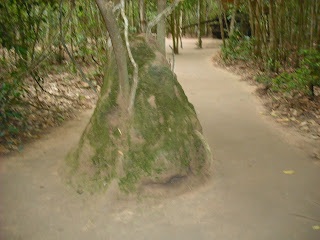





The Tunnels of Cu Chi get around 300,000 visitors a year. It is very well organized with scads of tour guides who take individuals or groups through a series of stations, including hunkering down to crawl through a portion of the tunnels. The tunnels were a honeycomb of meeting rooms, hospitals, bomb making rooms, kitchens, and firing positions, interspersed in a total of 160 miles of tunnels in Tay Ninh province, which lies 30 miles northwest of Saigon up to the Cambodian border. It lay under the area of operations of the U.S. 25th Infantry (Tropic Lightning) Division and the 1st Infantry (Big Red One) Division. A lot of death and destruction was rained down on the area by advanced U.S.weaponry, yet the people around Cu Chi continued to frustrate military operations with guerilla tactics and highly motivated resistence. The GIs were bravely fighting for an ill-conceived policy that supported a corrupt South Viet Nam government only because it was anti -communist. The popular front of Vietnamese - rice farmers by day, guerillas by night - were extraordinarilly courageous in their fight to rid their land of foreign devils from 10,000 miles away. There was an old Vietnamese saying that said the emporer's rule ends at the village gates. How poignant that was. Pictured above: A destroyed U.S. tank from home-made land mine from U.S. ordnance, rubber tree plantation that was re-planted from utter destruction, a B-52 bomb crater and natural vegetation that has come back from a large landscape that looked like the surface of the moon after napalm and tons of ordnance, a termite mound disguising a ventilator, an under ground meeting room, a small access hole to the tunnel system.



Wow, familiar rubber plantation sight--right in the thick of it.
ReplyDelete